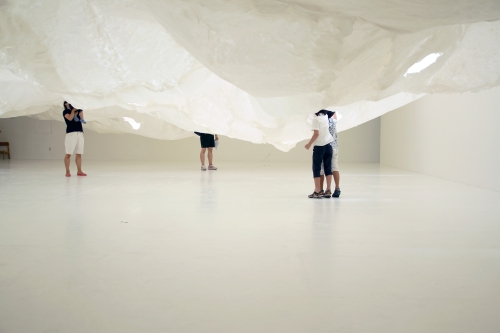Japanese artist Takashi Kuribayashi explores borders
The surreal experience could best be explained as a moment experiencing a bugs’ eye view.
Everything was mystically white at beyond museum in Cheongdam-dong, southern Seoul. Stepping in under the large, thin and uneven sheet of Japanese traditional paper horizontally dividing the first floor, it felt like entering an unidentified underground tunnel. Marking about 1 meter at the lowest and about 1.7 meter at the highest, the paper layer allowed visitors to stand up straight only at few points and stoop down low at the rest.
While exploring the unfamiliar and uncomfortable space, one came across a few holes pierced above that looked as if a mole had burrowed through. Each hole let in a streak of even whiter light, enticing the adventurers below to peek into the world above.
Surprisingly, it took a few seconds to gather up the courage to ignore the uneasy feeling of having to venture past the safety zone. When one finally did peek through the hole, a whole new world was unveiled ― a forest packed with numerous white larches.
The surreal experience could best be explained as a moment experiencing a bugs’ eye view.
Everything was mystically white at beyond museum in Cheongdam-dong, southern Seoul. Stepping in under the large, thin and uneven sheet of Japanese traditional paper horizontally dividing the first floor, it felt like entering an unidentified underground tunnel. Marking about 1 meter at the lowest and about 1.7 meter at the highest, the paper layer allowed visitors to stand up straight only at few points and stoop down low at the rest.
While exploring the unfamiliar and uncomfortable space, one came across a few holes pierced above that looked as if a mole had burrowed through. Each hole let in a streak of even whiter light, enticing the adventurers below to peek into the world above.
Surprisingly, it took a few seconds to gather up the courage to ignore the uneasy feeling of having to venture past the safety zone. When one finally did peek through the hole, a whole new world was unveiled ― a forest packed with numerous white larches.


Taking in the marvelous sight from the ground level ― or at bugs’ eye view ― one would come to realize that he/she may have easily ended up being nothing more than a small miserable creature who never found out about the superior world, if one had lacked courage or the chance to meet the hole.
“The environment is classified into two parts, the inherent one and that in man’s mind. Both are the environment. Inevitably, there exists a ‘borderline’ between the two, and I can’t judge which is correct and which is wrong, as I am a man. However, it is necessary to reconsider how selfish the environment in man’s mind is. I hope my work can offer a chance to understand that,” said Takashi Kuribayashi, artist of the big-scale installation work “Forest from Forest,” prior to the exhibition.
The Japanese artist is known for his wide range of works that ponder on the flexibility of borders and the worlds divided by them, and environmental issues. He often features seals in his works, which live in water and land ― both sides of the border.
The show is his first-ever solo exhibition in Korea, and also the first since the earthquake that hit northeastern Japan in March, which he said is a turning point in his art world. He produced more environmental-focused works like “Iceberg,” in which he froze a large mountain range-shaped ice and placed it in a glassed fridge, after the deadly natural disaster. He planted several plants that were irradiated after the earthquake in the ice. The artwork is found on the second floor of the museum.
“Under the Water,” a work connected to “Forest from Forest,” is a bit of a thriller. As one climbs up a ladder and pokes his/her head through a hole in a temporary ceiling installed above, the watery surrounding found there presents the feeling of being stuck in an inundated building where it is already flooding up to neck-level. The goose bumps come when the onlooker looks around the space and meets eye-to-eye to one’s own reflection in a mirror placed at a side.
“I would be thankful if visitors are just moved or provoked into thinking when they see my work. As an artist, I think that it is enough to show absurdity, a borderline, or a gap between the two environments, and let them put on their thinking caps while they appreciate my work, instead of stressing any particular side,” said the artist.
The exhibition runs through Oct. 16 at beyond museum in Cheongdam-dong, southern Seoul. Tickets range from 6,000 won to 8,000 won. For more information, call (02) 577-6688 or visit www.beyondmuseum.com.
By Park Min-young (claire@heraldcorp.com)







![[KH Explains] How should Korea adjust its trade defenses against Chinese EVs?](http://res.heraldm.com/phpwas/restmb_idxmake.php?idx=644&simg=/content/image/2024/04/15/20240415050562_0.jpg&u=20240415144419)










![[Today’s K-pop] Stray Kids to return soon: report](http://res.heraldm.com/phpwas/restmb_idxmake.php?idx=642&simg=/content/image/2024/04/16/20240416050713_0.jpg&u=)